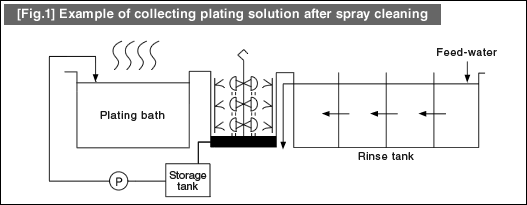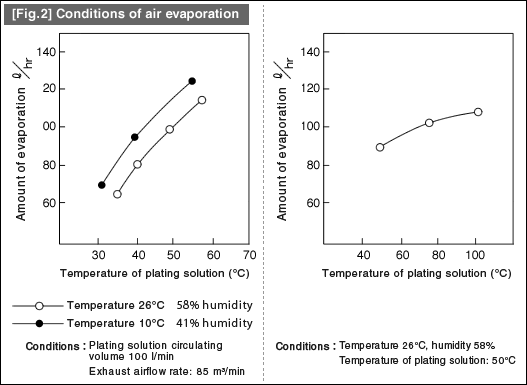#234 Saving Water for Washing and Cleaning (Collecting Plating Solution)
[Fig.1] illustrates the system with a spray-cleaning unit adopted prior to the process of countercurrent multistage washing. Spray cleaning is a highly effective method of cleaning products using a small amount of water.

This system has the two characteristics.
One of them is the significant reduction of plating solution brought into the first rinse tank since almost all of the plating solution will be removed by spray cleaning. This can greatly reduce the overall water usage for washing and cleaning.
The second characteristic is that relatively thick plating solution separated by spray cleaning can be restored back to the plating bath as long as the amount is within a range of natural evaporation from the plating bath. The amount of natural evaporation increases when the operating temperature of the plating bath is relatively high. As shown in [Fig.1], the plating solution can be collected easily under this condition.
If it is not possible to restore the entire plating solution collected due to insufficient evaporation volume, collect them by forcibly vaporizing the separated solution. To vaporize plating solution forcibly, adopt the "air evaporation" method used for cooling towers. At this time, the heating unit of the plating bath supplies latent heat of water evaporation.
When the solution has low bath temperature or is likely to dissolve, the batch-type vacuum evaporation can be also adopted.
Evaporation of the plating solution is significantly affected by its temperature and circulating volume, exhaust airflow rate, external temperature and humidity, etc.[Fig.2] shows the conditions of evaporation.

- Environmental conservation
- Hot Dipping
- Anodic Oxidation Process
- Anodic oxidation treatment
- Anodizing
- Corrosion - Corrosion Protection
- Electroless Plating
- Electroplating
- Heat treating
- Hydrogen embrittlement
- Metal cleaning
- Metal etching
- Painting
- Special paints
- Surface Treatment
- Surface-treated steel sheets
- Thermal Spraying



